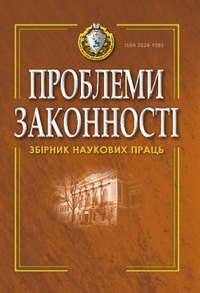Formation of the institute of electronic evidence in the criminal process of Ukraine
DOI:
https://doi.org/10.21564/2414-990x.146.171218Keywords:
evidence, source, electronic, fixation, criminal proceeding, UkraineAbstract
In this article, we investigate the phenomenon of "electronic evidence" in the criminal proceeding of Ukraine. We conducted an analysis of the statements of scientists and determined that there is no unity in the approaches to the definition of the phenomenon under study. In addition, scientists do not have a common position as to which place the "electronic evidence" takes in the system of procedural sources of evidence. We highlighted the actual problem, which consists in the artificial formation of the Institute of "electronic evidence" in the science of the criminal proceeding. We also express disagreement with the position of the economic procedural, civil procedural and administrative procedural legislation of Ukraine, which separate "electronic evidence". We substantiated our statement with the fact that scientists cannot apply such characteristics as the form of fixing information, the characteristics of the medium of the information or the way of reproduction of data, in order to separate a new source of the evidence. We have analyzed the criminal procedural legislation of European states. They shows the absence of a pan-European practice of legislative consolidation of the institute of "electronic evidence". We notes in the article that the source of information transformed into the evidence by addition to a particular criminal proceeding. This occurs through procedural fixation, in accordance with the CPC of Ukraine. Consequently, the final format of evidence, including the electronic, depends on the nature of the source of information, and on the procedural design, to the same extent. The four sources of evidence may have an electronic form, taking into account the current criminal procedural legislation and current conditions. We conclude that the term "electronic evidence" should be exclusively a theoretical category. We also argue that the institute of "electronic evidence" is artificial and it cannot substitute the electronic form of the fixation of the evidence. We have determined that because of the development of information technology, we can created the electronic information, which will give us the need to expand the sources of evidence - for example, add electronic ones. This will require that we make changes to the criminal procedural law, and that we make a clear distinction between the electronic sources of evidence and the fixation of the evidence in electronic format.
References
Konventsiia Rady Yevropy pro kiberzlochynnist vid 23.11.2001 r., ratyfikovana Zakonom №2824-IV vid 07.09.2005 r.. URL: https://zakon.rada.gov.ua/laws/show/994_575 [in Ukrainian].
Kryminalnyi protsesualnyi kodeks Ukrainy: Zakon Ukrainy vid 13.04.2012 r. № 4651 VI (zi zmin. i dop.). URL: http://zakon2.rada.gov.ua/laws/show/4651-17 [in Ukrainian].
Tsyvilnyi protsesualnyi kodeks Ukrainy vid 18.03.2004 r. № 1618-IV. URL: http://zakon.rada.gov.ua/laws/show/1618-15 [in Ukrainian].
Kriminalprocesa likums. Latvijas Republikas. Likums Saeimā pieņemts 21.04.2005 r. (ar grozijumiem). URL: https://likumi.lv/ta/id/107820 [in Latvian].
Alieksieieva-Protsiuk, D. O., Bryskovska, O. M. (2018). Elektronni dokazy v kryminalnomu sudochynstvi: poniattia, oznaky ta problemni aspekty zastosuvannia. Naukovyi visnyk publichnoho ta pryvatnoho prava – Scientific bulletin of public and private law, issue 2. 247–253 [in Ukrainian].
Akhtyrska, N. M. (2016). Do pytannia dokazovoi syly kiberinformatsii v aspekti mizhnarodnoho spivrobitnytstva pid chas kryminalnoho provadzhennia. Naukovyi visnyk Uzhhorodskoho natsionalnoho universytetu – Scientific bulletin of Uzhhorod university, issue 36 (2), 123–125 [in Ukrainian].
Bilousov, A. S. (2008). Kryminalistychnyi analiz obiektiv kompiuternykh zlochyniv. Extended abstract of candidate’s thesis. Kyiv [in Ukrainian].
Vasyliev, S. V., Nikolenko, L.M. (2004). Dokazuvannia ta dokazy u hospodarskomu protsesi Ukrainy. Kharkiv: Espada [in Ukrainian].
Hrebeniuk, M. V., Havlovskyi, V. D., Hutsaliuk, M. V., Khakhanovskyi, V. H. et al. (2017). Vykorystannia elektronnykh (tsyfrovykh) dokaziv u kryminalnomu provadzhenni. Kyiv: MNDTs pry RNBO Ukrainy [in Ukrainian].
Volkov, O.O. (2018). Osnovni dzherela kryminalistychno-znachymoi informatsii pro zlochyny poviazani z shkidlyvymy prohramnymy zasobamy. Innovative solutions in modern science, 3 (22), 15 [in Ukrainian].
Davydiuk, P. P., Kubai, I.Iu. (2017). Vysunennia i perevirka slidchykh versii pro tsyfrove alibi pidozriuvanoho (obvynuvachenoho). Molodyi vchenyi – Young Scientist, 5 (45), 29–32 [in Ukrainian].
Dokazuvannia u kryminalnomu provadzhenni. (2017). Kyiv: Natsionalna akademiia prokuratury Ukrainy [in Ukrainian].
Drozdov, O, Drozdova, O. (2017). Aktualni pytannia dotrymannia vymoh punktiv 1 ta 3 (d) statti 6 Konventsii na prykladi spravy Dashtan proty Turechchyny (z komentariamy). Visnyk natsionalnoi asotsiatsii advokativ Ukrainy – Bulletin of theUkrainian national bar association, 11, 29–41 [in Ukrainian].
Kotliarevskyi, O. I., Kytsenko, D. M. (1998). Kompiuterna informatsiia yak rechovyi dokaz u kryminalnii spravi. Informatsiini tekhnolohii ta zakhyst informatsii – Information technologies and information protection, 2, 70–79 [in Ukrainian].
Krytska, I. O. (2016). Rechovi dokazy ta tsyfrova informatsiia: poniattia ta spivvidnoshennia. Chasopys Kyivskoho universytetu prava – Chronicles of Kyiv University of Law, 1, 301-305 [in Ukrainian].
Krytska, I. O. (2017). Rechovi dokazy u kryminalnomu provadzhenni. Candidate’s thesis. Kharkiv [in Ukrainian].
Muradov, V. V. (2013) Elektronni dokazy: kryminalistychnyi aspekt vykorystannia. Porivnialno-analitychne pravo– Comparative and analytical right, 3–2, 313–315 [in Ukrainian].
Orlov, Yu. Iu., Cherniavskyi, S. S. (2017). Elektronne vidobrazhennia yak dzherelo dokaziv u kryminalnomu provadzhenni. Yurydychnyi chasopys Natsionalnoi akademii vnutrishnikh sprav – Law Magazine of the National Academy of Internal Affairs, 1 (13), 12–22 [in Ukrainian].
Seleznov, V. V. (2006). Osnovy rynkovoi ekonomiky Ukrainy. Kyiv: A.S.K. [in Ukrainian].
Slovnyk ukrainskoi movy. (Vols. 1–11); Vol. 6. (1975). URL: http://sum.in.ua/s/pysjmovyj [in Ukrainian].
Tsekhan, D. M. (2013). Tsyfrovi dokazy: poniattia, osoblyvosti ta mistse v systemi dokazuvannia. Naukovyi visnyk Mizhnarodnoho humanitarnoho universytetu. Ser.: Yurysprudentsiia – International Humanitarian University Herald. Jurisprudence, 5, 256–260 [in Ukrainian].
Downloads
Published
How to Cite
Issue
Section
License
Copyright (c) 2019 Антон Володимирович Столітній, Інга Георгіївна Каланча

This work is licensed under a Creative Commons Attribution 4.0 International License.










